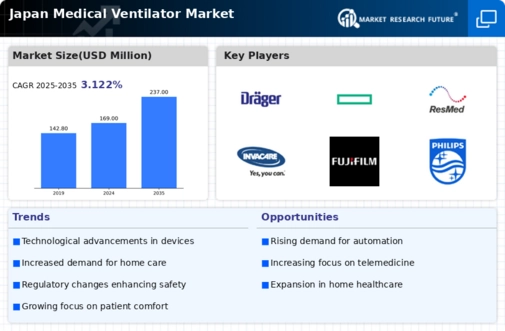Aging Population
The aging population in Japan is a critical driver for the medical ventilator market. As the demographic shifts towards an older age group, the prevalence of chronic respiratory diseases increases. According to government statistics, approximately 28% of the population is aged 65 and older, leading to a heightened demand for respiratory support devices. This demographic trend suggests that healthcare facilities will require more advanced ventilators to cater to the needs of elderly patients. Furthermore, The market is likely to see a surge in demand as hospitals and care facilities adapt to provide adequate respiratory care for this growing segment. The increasing life expectancy also correlates with a rise in comorbidities, further driving the need for effective ventilatory support in clinical settings.
Technological Innovations
Technological innovations play a pivotal role in shaping the medical ventilator market. The introduction of advanced features such as non-invasive ventilation, smart monitoring systems, and automated settings enhances the efficiency and effectiveness of ventilators. In Japan, the market is witnessing a shift towards high-tech solutions that improve patient outcomes. For instance, the integration of artificial intelligence in ventilators allows for real-time adjustments based on patient needs, which could potentially reduce the duration of mechanical ventilation. The market is projected to grow at a CAGR of around 7% over the next five years, driven by these innovations. As healthcare providers seek to improve patient care, the demand for technologically advanced ventilators is expected to rise significantly.
Increased Healthcare Expenditure
Increased healthcare expenditure in Japan is a significant driver for the medical ventilator market. The government has been investing heavily in healthcare infrastructure, aiming to enhance the quality of care provided to patients. In recent years, healthcare spending has risen to approximately 10% of the GDP, reflecting a commitment to improving medical services. This financial support enables hospitals and healthcare facilities to acquire advanced medical equipment, including ventilators. As a result, the medical ventilator market is likely to benefit from this trend, as facilities upgrade their equipment to meet the growing demand for respiratory care. The focus on improving healthcare services is expected to sustain the growth of the market in the coming years.
Government Initiatives and Support
Government initiatives and support for respiratory health are vital drivers of the medical ventilator market. The Japanese government has implemented various programs aimed at improving respiratory care and increasing awareness of respiratory diseases. These initiatives often include funding for research and development in medical technologies, which can lead to the creation of more effective ventilators. Additionally, public health campaigns aimed at reducing smoking rates and promoting lung health contribute to a healthier population, potentially decreasing the overall burden of respiratory diseases. As a result, the medical ventilator market is likely to experience growth as the government continues to prioritize respiratory health and support advancements in medical technology.
Rising Incidence of Respiratory Diseases
The rising incidence of respiratory diseases in Japan is a crucial factor influencing the medical ventilator market. Conditions such as chronic obstructive pulmonary disease (COPD) and asthma are becoming increasingly prevalent, necessitating the use of ventilatory support. Recent studies indicate that around 5 million people in Japan suffer from COPD, highlighting the urgent need for effective respiratory management solutions. This trend is likely to drive the demand for medical ventilators, as healthcare providers seek to offer comprehensive care for patients with respiratory conditions. This market is expected to expand as hospitals and clinics invest in advanced ventilatory technologies to address this growing health concern.





















Leave a Comment